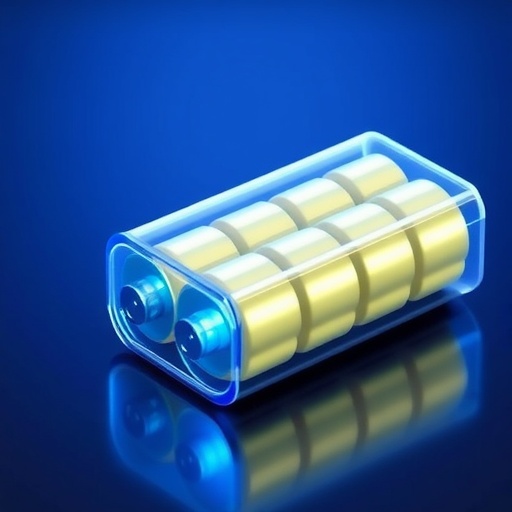In a groundbreaking advancement that could redefine the future of energy storage, researchers from the Dalian Institute of Chemical Physics (DICP), under the Chinese Academy of Sciences, have unveiled the first room temperature rechargeable all-solid-state hydride ion battery. This pioneering work, led by Prof. CHEN Ping’s group and recently published in Nature, marks a significant leap in electrochemical technology by harnessing hydride ions (H⁻) as the charge carriers—a novel approach that promises to overcome the longstanding challenges of efficiency, stability, and safety in battery design.
Hydride ions, characterized by their low mass and exceptional redox potential, have long tantalized scientists with their potential to serve as superior charge carriers. Unlike the conventional lithium-ion systems that dominate today’s energy landscape, hydride ion batteries operate on the transfer of H⁻ ions, offering advantages such as higher energy density and lower dendritic risks. Yet, progress has been derailed by the absence of suitable electrolytes capable of facilitating rapid hydride ion conduction at ambient temperatures, while also withstanding rigorous electrochemical and thermal conditions.
Addressing this critical bottleneck, the DICP team engineered an innovative core–shell composite hydride electrolyte, denoted as 3CeH₃@BaH₂, where cerium hydride (CeH₃) forms the core enveloped by a barium hydride (BaH₂) shell. This heterojunction-inspired design synergistically combines the intrinsic high ionic conductivity of CeH₃ with the robust structural stability of BaH₂. The resulting composite electrolyte exhibits remarkable hydride ion transport kinetics at room temperature, a feat previously unattainable with single-phase hydride materials.
The core–shell architecture operates on the principle that the BaH₂ shell not only safeguards the CeH₃ core from degradation but also contributes to an extended electrochemical window, ensuring the material’s resilience in repeated cycling. This intricate interplay between phases facilitates fast and stable conduction pathways for hydride ions, overcoming typical barriers of electrolyte decomposition and limited ionic movement encountered in prior research.
Building upon the electrolyte breakthrough, the team assembled an all-solid-state hydride ion battery consisting of a CeH₂ anode, the novel 3CeH₃@BaH₂ electrolyte separator, and a cathode composed of NaAlH₄—a classical hydrogen storage material prized for its reversible H− capacity. This choice of cathode not only underscores the battery’s sustainability but also leverages the well-understood hydrogen chemistry intrinsic to NaAlH₄, known for its compatibility with hydride ions. The novel battery design successfully achieved a high initial discharge capacity of 984 mAh/g at room temperature, confirming the electrolyte’s efficacy in practical application.
Over a series of 20 charge-discharge cycles, the battery maintained a capacity of 402 mAh/g, demonstrating promising cyclability and operational stability without significant degradation. Such retention rates hint at the core-shell electrolyte’s durability and the compatibility of hydride ion chemistry within a solid-state framework—issues that have plagued many experimental battery systems attempting to transcend liquid electrolytes’ limitations.
The hydride ion battery’s operating voltage was measured at an impressive 1.9 V in a stacked configuration, a voltage sufficient to power real-world devices such as a yellow light-emitting diode (LED) lamp, as demonstrated by the researchers. This clear proof-of-concept underscores the technology’s readiness for practical energy storage applications, highlighting its potential utility in portable electronics, electric vehicles, and possibly grid storage, where high energy density and safety are paramount.
One of the most compelling advantages of utilizing hydrogen-based charge carriers, specifically hydride ions, is the near elimination of dendrite formation—a notorious issue in lithium metal batteries that leads to short circuits and catastrophic failures. This intrinsic dendrite suppression greatly enhances battery lifespan and safety, pivotal factors for widespread commercial adoption. The all-solid-state nature further contributes to operational safety by circumventing volatile, flammable liquid electrolytes commonly used in current lithium-ion systems.
The implications of this technology extend beyond performance metrics. The use of earth-abundant and relatively inexpensive materials such as cerium and barium hydrides could moderate production costs, addressing critical economic barriers in next-generation battery manufacturing. Given that scalability remains a critical hurdle for any nascent battery technology, the simplicity and stability of these hydride compounds bode well for potential industrial deployment.
This success also opens up a broader landscape for hydride ion battery research, inviting deeper investigation into tuning hydride-based materials’ structural, electrochemical, and interfacial properties. Such tunability offers a promising pathway to optimize energy density, charge rates, and cycle life, potentially surpassing the capabilities of current lithium-ion and emerging sodium-ion battery technologies.
Moreover, the demonstration of fast hydride ion conduction at room temperature challenges longstanding assumptions about hydride mobility, which was traditionally viable only at elevated temperatures. This breakthrough shifts the paradigm, enabling energy storage devices to function efficiently under ambient conditions without resorting to complex thermal management systems—a crucial factor for consumer electronics and electric transportation.
By harnessing the synergy of novel material design and robust chemical understanding, Prof. CHEN Ping’s team has charted an exciting course toward viable, safe, and sustainable electrochemical energy storage solutions that could integrate seamlessly into the ever-evolving clean energy ecosystem. If further optimized and commercialized, hydride ion batteries may well become frontrunners in the pursuit of more efficient, environmentally friendly, and resilient power sources for the next century.
As the global push intensifies toward decarbonization and renewable energy integration, the development of innovative battery chemistries like the hydride ion system is essential. Its unique approach, centered on hydrogen-based ions and solid-state materials, situates it as a promising candidate to overcome prevailing battery challenges—ushering in an era where electrochemical devices combine performance, safety, and sustainability without compromise.
This study not only provides a compelling proof-of-concept for hydride ion batteries but also lays a foundational framework for future research into advanced hydride electrolytes. By expanding the fundamental understanding of hydride ion transport and battery assembly using core-shell heterostructures, this work amplifies the horizon of electrochemical science and lays the groundwork for next-generation energy storage technologies.
Subject of Research: Not applicable
Article Title: A room temperature rechargeable all-solid-state hydride ion battery
News Publication Date: 17-Sep-2025
Web References: http://dx.doi.org/10.1038/s41586-025-09561-3
Image Credits: Dalian Institute of Chemical Physics (DICP)
Keywords
Batteries, Electrolytes, Electrochemical cells




